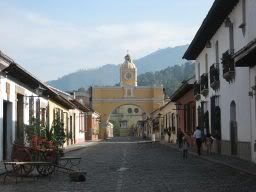Charming little Antigua (a.k.a., Gringolandia)

Classic Antigua: cobblestone streets with a view Volcán Agua from just about everywhere in town.
If you visit Guatemala, chances are you’ll end up in Antigua. Just an hour outside the seriously urban (i.e., crowded, dirty, dangerous) capital of Guatemala City, it couldn’t be more different. Antigua (I believe its official name is actually La Antigua Guatemala – "The Old Guatemala") is a classic colonial town nestled between several volcanoes and lined with cobblestone streets. It was the first capital of Guatemala during the Spanish colonial times, originally named Santiago. Apparently, the Spanish named a lot of their colonial capitals “Santiago”, thereby explaining the excessive number of “Santiagos” in Latin America. Similarly, the imported Catholic faith explains the reason why the region is also rife with towns named San Pedro (Saint Peter).
Because of the city’s propensity to be destroyed every so often by earthquakes, the Spanish decided to move the capital from Antigua to Guatemala City in the late 18th century, after a particularly nasty earthquake had leveled the town in the 1770s. Antigua is still filled with remnants of the colonial days – there are buildings and (especially!) churches that are beautifully restored, just as there are still crumbling ruins that remain. The entire town is appropriately designated as a UNESCO World Heritage Site.

The ruins of an old church in Antigua.
In any case, Antigua is impossibly charming. Really lovely with a very European feel – at times, you wouldn’t even know you were in Guatemala. Still, I had avoided Antigua like the plague during my first three months in the country because of its reputation as “Gringolandia.” The city is famed for its Spanish schools, but, ironically, because of the popularity of tourism here, you can actually walk around Antigua all day without speaking any Spanish at all. Eventually, I caved and visited twice: spending a night when I traveled my way back to Xelá from my 3-week holiday and another night before I flew back to the U.S. (because I hate staying overnight in Guatemala City!).
The only bad part about my stay in Antigua was the youth hostel where I stayed during my second visit (during my first visit, I stayed at a basic but cheap local guesthouse owned by some lovely Guatemalans). Usually I don’t do the hostel thing, as I find that I have little in common with young’uns who travel solely to party and get drunk or high. That said, it wasn’t a bad hostel – in fact, it was quite new and packed full of nice travelers (in my room, anyway). Rather, my experience involved an incident that further reminded me of the inequalities that exist in countries like Guatemala, and the price that locals have to pay for the benefits of tourism. I had to wait for my airport shuttle very early in the morning (around 3:30 AM), so it was basically me and the hostel’s nighttime security guard, an older gentleman named Javier, sitting around for awhile. I asked how he was (the usual niceties of waiting-around conversation), and we ended up chatting for a bit about his work. That particular night was Javier’s last night of work after 3 weeks on the job – he confessed that he could no longer take the rude, drunk gringos stumbling in every night and giving him a hard time for no reason, so he was quitting the next day. He used to be a tour guide for local Guatemalans, but now the English-speaking tourists far outnumber local ones, so work is hard to come by. Javier took the security guard job at the hostel because he needed work, but he only got paid Q$50 (US$6.50) for 9 hours of work (whereas the hostel charged Q$50 per night per person – and the place was full every night). Of course, many people in Guatemala would feel lucky to make Q$50, but this is Antigua – where prices are simply sky-high for everyone because of tourists. He seemed pretty bummed, not only about his impending unemployment, but also about the fact that rude, dumbass gringos were ruling the streets of Antigua and not respecting local culture. When my shuttle came, I said thank you and goodbye to Javier, and he said that it was a pleasure to finally talk to someone nice. This made me happy and sad at the same time.

The famous Antigua Arch.
Despite the drunken assholes that give gringos a bad name, I can say that – for the most part – I do like Antigua. There are terrific museums (hello, Textiles and Weaving!), restaurants, art galleries, shops (Antigua is famous for jade), and hotels (not like I was able to afford any of the nice ones). One of the favorite places that I visited was Casa Popenoe, an old colonial home from the 1600s that was restored by an American businessman who lived in Antigua in the 1930s. It’s amazing, and the original owner’s daughters (now in their 70s) still live there! I only regret that I wasn’t able to climb Volcán Pacaya, a nearby volcano that is still active – you can even see the lava flow from the top. All in all, Antigua was a great way to spend my last day in Guatemala. Maybe next time I will stay in Antigua for more than 24 hours at a time? :)

Speaking of “lasts” in Guatemala, my last meal was quite Guatemala-appropriate: Pollo Campero. Campero, as it’s known, is just fast food fried chicken, but it’s amazingly tasty. Chapines (nickname for Guatemalans) are very proud of the chain, because it’s a Guatemalan-owned company that is so successful that KFC is actually unable to enter the domestic fried chicken market! There is actually a Campero restaurant in the Guatemala City Airport, and many Guatemalans flying out of the country – presumably to visit their relatives abroad – buy huge 24-piece boxes of fried chicken as gifts. The smell on the plane almost drove me crazy...I should have been so smart as to buy a box for myself. Mmmm...chicken.

As long as we’re talking about food, I might as well share this lovely photo of my last meal in Xelá, from my favorite (and only) Indian (yes, Indian!) restaurant in town. Mmmm...I miss those mango-pineapple licuados (smoothies) already.

1 Comments:
A note on "Santiago"-- This is also a Catholic name; it means Saint James. The most famous Santiago is the pilgrimage site Santiago de Compostela, in Gallego, the northwesternmost region of Spain. After Rome, it was the most important pilgrimage site of the middle ages. The eponymous Sant' Iago, by the way, was a Crusader, and he was also known as "Santiago Matamoros," which means... well, you took Spanish, so you know what it means. *Cringe.*
Post a Comment
<< Home